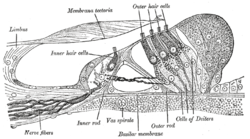
Back خلية شعرية Arabic Trepljasta ćelija BS Vlásková buňka Czech Haarzelle German Células ciliadas Spanish سلول مویی Persian Cellule ciliée French תא שערה HE Sel rambut ID Cellula ciliata Italian
| Hair cell | |
|---|---|
 Section through the spiral organ of Corti. Magnified. ("Outer hair cells" labeled near top; "inner hair cells" labeled near center). | |
 Cross-section of the cochlea. The inner hair cells are located at the termination of the "inner hair cell nerves" and the outer hair cells are located at the termination of the "outer hair cell nerve". | |
| Details | |
| Location | Cochlea |
| Shape | Unique (see text) |
| Function | Amplify sound waves and transduce auditory information to the brainstem |
| Neurotransmitter | Glutamate |
| Presynaptic connections | None |
| Postsynaptic connections | Via auditory nerve to vestibulocochlear nerve to inferior colliculus |
| Identifiers | |
| NeuroLex ID | sao1582628662, sao429277527 |
| Anatomical terms of neuroanatomy | |
Hair cells are the sensory receptors of both the auditory system and the vestibular system in the ears of all vertebrates, and in the lateral line organ of fishes. Through mechanotransduction, hair cells detect movement in their environment.[1]
In mammals, the auditory hair cells are located within the spiral organ of Corti on the thin basilar membrane in the cochlea of the inner ear. They derive their name from the tufts of stereocilia called hair bundles that protrude from the apical surface of the cell into the fluid-filled cochlear duct. The stereocilia number from fifty to a hundred in each cell while being tightly packed together[2] and decrease in size the further away they are located from the kinocilium.[3]
Mammalian cochlear hair cells are of two anatomically and functionally distinct types, known as outer, and inner hair cells. Damage to these hair cells results in decreased hearing sensitivity, and because the inner ear hair cells cannot regenerate, this damage is permanent.[4] Damage to hair cells can cause damage to the vestibular system and therefore cause difficulties in balancing. However, other vertebrates, such as the frequently studied zebrafish, and birds have hair cells that can regenerate.[5][6] The human cochlea contains on the order of 3,500 inner hair cells and 12,000 outer hair cells at birth.[7]
The outer hair cells mechanically amplify low-level sound that enters the cochlea.[8][9] The amplification may be powered by the movement of their hair bundles, or by an electrically driven motility of their cell bodies. This so-called somatic electromotility amplifies sound in all tetrapods. It is affected by the closing mechanism of the mechanical sensory ion channels at the tips of the hair bundles.[citation needed]
The inner hair cells transform the sound vibrations in the fluids of the cochlea into electrical signals that are then relayed via the auditory nerve to the auditory brainstem and to the auditory cortex.
- ^ Lumpkin, Ellen A.; Marshall, Kara L.; Nelson, Aislyn M. (2010). "The cell biology of touch". The Journal of Cell Biology. 191 (2): 237–248. doi:10.1083/jcb.201006074. PMC 2958478. PMID 20956378.
- ^ McPherson, Duane (June 18, 2018). "Sensory Hair Cells: An Introduction to Structure and Physiology". Integrative and Comparative Biology. 58 (2): 282–300. doi:10.1093/icb/icy064. PMC 6104712. PMID 29917041.
- ^ Schlosser, Gerhard (June 1, 2018). "A Short History of Nearly Every Sense – The Evolutionary History of Vertebrate Sensory Cell Types". Integrative and Comparative Biology. 58 (2): 301–316. doi:10.1093/icb/icy024. PMID 29741623.
- ^ Nadol, Joseph B. (1993). "Hearing loss". New England Journal of Medicine. 329 (15): 1092–1102. doi:10.1056/nejm199310073291507. PMID 8371732.
- ^ Lush, Mark E.; Piotrowski, Tatjana (2013). "Sensory hair cell regeneration in the zebrafish lateral line". Developmental Dynamics. 243 (10): 1187–1202. doi:10.1002/dvdy.24167. PMC 4177345. PMID 25045019.
- ^ Cotanche, Douglas A. (1994). "Hair cell regeneration in the bird cochlea following noise damage or ototoxic drug damage". Anatomy and Embryology. 189 (1): 1–18. doi:10.1007/bf00193125. PMID 8192233. S2CID 25619337.
- ^ Rémy Pujol, Régis Nouvian, Marc Lenoir, "Hair cells (cochlea.eu)
- ^ Ashmore, Jonathan Felix (1987). "A fast motile response in guinea-pig outer hair cells: the cellular basis of the cochlear amplifier". The Journal of Physiology. 388 (1): 323–347. doi:10.1113/jphysiol.1987.sp016617. ISSN 1469-7793. PMC 1192551. PMID 3656195.
- ^ Ashmore, Jonathan (2008). "Cochlear Outer Hair Cell Motility". Physiological Reviews. 88 (1): 173–210. doi:10.1152/physrev.00044.2006. ISSN 0031-9333. PMID 18195086. S2CID 17722638.